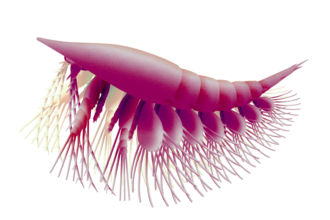Biology:Oelandocaris
| Oelandocaris | |
|---|---|

| |
| Life restoration | |
| Scientific classification | |
| Domain: | Eukaryota |
| Kingdom: | Animalia |
| Phylum: | Arthropoda |
| Family: | †Oelandocarididae |
| Genus: | †Oelandocaris Müller, 1983 |
| Species: | †O. oelandica
|
| Binomial name | |
| †Oelandocaris oelandica Müller, 1983
| |
Oelandocaris is an extinct genus of stem-mandibulate,[1] or possibly a megacheiran,[2] within the monotypic family Oelandocarididae.
Description
Oelandocaris has a large head segment with a possible median eye, similar to peytoiids, making up roughly one half of its body.[3] It has five tergites, each with a biramous limb pair and a spike on their ends, and a cylindrical tail segment. In addition, the head has two biramous limb pairs, antennae and antennules, the posterior similar in structure to the bodily limbs, the anterior including the possible mandibles. It also has a pair of possible great appendages. The whole animal only measures about a millimetre long, similar in size to other Orsten fauna.
Ecology
As the exopods of Oelandocaris's limbs are large and flattened, it is very likely that it was a swimming animal, and presumably planktonic, based on its size.
Etymology
Oelandocaris derives from the island of Öland in Sweden, a primary location for Orsten fossils, and the Greek word καρίς, meaning "shrimp" or "crab".[3]
Distribution
Oelandocaris is known from six specimens, all from the Orsten lägerstatten. The original specimen only preserved the body, however more complete specimens including limbs have been found.
References
- ↑ "Oelandocaris oelandica and the stem lineage of Crustacea". https://www.researchgate.net/publication/285312719.
- ↑ Aria, Cédric; Caron, Jean-Bernard (2017). "Burgess Shale fossils illustrate the origin of the mandibulate body plan". Nature 545 (7652): 89–92. doi:10.1038/nature22080. PMID 28445464. Bibcode: 2017Natur.545...89A. https://www.nature.com/articles/nature22080.
- ↑ 3.0 3.1 Müller, Klaus J. (1983). "Crustacea with preserved soft parts from the Upper Cambrian of Sweden". Lethaia 16 (2): 93–109. doi:10.1111/j.1502-3931.1983.tb01704.x. https://www.idunn.no/doi/pdf/10.1111/j.1502-3931.1983.tb01704.x.
Wikidata ☰ Q123569490 entry
 |

